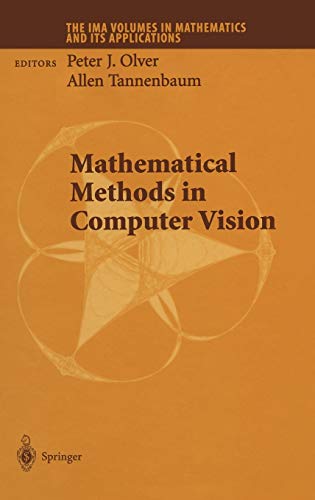Mathematical Methods in Computer Vision: 133 (The IMA Volumes in Mathematics and its Applications) - Tapa dura

Sinopsis
This volume comprises some of the key work presented at two IMA Workshops on Computer Vision during fall of 2000. Recent years have seen significant advances in the application of sophisticated mathematical theories to the problems arising in image processing. Basic issues include image smoothing and denoising, image enhancement, morphology, image compression, and segmentation (determining boundaries of objects-including problems of camera distortion and partial occlusion). Several mathematical approaches have emerged, including methods based on nonlinear partial differential equations, stochastic and statistical methods, and signal processing techniques, including wavelets and other transform theories. Shape theory is of fundamental importance since it is the bottleneck between high and low level vision, and formed the bridge between the two workshops on vision. The recent geometric partial differential equation methods have been essential in throwing new light on this very difficult problem area. Further, stochastic processes, including Markov random fields, have been used in a Bayesian framework to incorporate prior constraints on smoothness and the regularities of discontinuities into algorithms for image restoration and reconstruction. A number of applications are considered including optical character and handwriting recognizers, printed-circuit board inspection systems and quality control devices, motion detection, robotic control by visual feedback, reconstruction of objects from stereoscopic view and/or motion, autonomous road vehicles, and many others.
"Sinopsis" puede pertenecer a otra edición de este libro.
Reseña del editor
This volume comprises some of the key work presented at two IMA Workshops on Computer Vision during fall of 2000. Recent years have seen significant advances in the application of sophisticated mathematical theories to the problems arising in image processing. Basic issues include image smoothing and denoising, image enhancement, morphology, image compression, and segmentation (determining boundaries of objects-including problems of camera distortion and partial occlusion). Several mathematical approaches have emerged, including methods based on nonlinear partial differential equations, stochastic and statistical methods, and signal processing techniques, including wavelets and other transform theories. Shape theory is of fundamental importance since it is the bottleneck between high and low level vision, and formed the bridge between the two workshops on vision. The recent geometric partial differential equation methods have been essential in throwing new light on this very difficult problem area. Further, stochastic processes, including Markov random fields, have been used in a Bayesian framework to incorporate prior constraints on smoothness and the regularities of discontinuities into algorithms for image restoration and reconstruction. A number of applications are considered including optical character and handwriting recognizers, printed-circuit board inspection systems and quality control devices, motion detection, robotic control by visual feedback, reconstruction of objects from stereoscopic view and/or motion, autonomous road vehicles, and many others.
"Sobre este título" puede pertenecer a otra edición de este libro.
Otras ediciones populares con el mismo título
Resultados de la búsqueda para Mathematical Methods in Computer Vision: 133 (The IMA...
Mathematical Methods in Computer Vision.
Librería: Universitätsbuchhandlung Herta Hold GmbH, Berlin, Alemania
Vol. 133. 86 figs., XI, 153 p. Hardcover. Versand aus Deutschland / We dispatch from Germany via Air Mail. Einband bestoßen, daher Mängelexemplar gestempelt, sonst sehr guter Zustand. Imperfect copy due to slightly bumped cover, apart from this in very good condition. Stamped. IMA Volumes in Mathematics and its Applications, Vol. 133. Sprache: Englisch. Nº de ref. del artículo: 679GB
Comprar usado
Cantidad disponible: 1 disponibles
Mathematical methods in computer vision.
Librería: Versandantiquariat Ingo Lutter, Buchholz, Alemania
Hardcover. Buch hat leichte Gebrauchs spuren ( Lese spuren ) Kanten leicht bestoßen 236 Englisch 400g. Nº de ref. del artículo: 45399
Comprar usado
Cantidad disponible: 1 disponibles
Mathematical Methods in Computer Vision
Librería: Romtrade Corp., STERLING HEIGHTS, MI, Estados Unidos de America
Condición: New. This is a Brand-new US Edition. This Item may be shipped from US or any other country as we have multiple locations worldwide. Nº de ref. del artículo: ABNR-88111
Comprar nuevo
Cantidad disponible: 1 disponibles
Mathematical Methods in Computer Vision
Librería: Basi6 International, Irving, TX, Estados Unidos de America
Condición: Brand New. New. US edition. Excellent Customer Service. Nº de ref. del artículo: ABEOCT25-80131
Comprar nuevo
Cantidad disponible: 1 disponibles
Mathematical Methods in Computer Vision
Librería: Books Puddle, New York, NY, Estados Unidos de America
Condición: New. pp. 172. Nº de ref. del artículo: 26280718
Comprar nuevo
Cantidad disponible: 1 disponibles
Mathematical Methods in Computer Vision
Librería: Majestic Books, Hounslow, Reino Unido
Condición: New. pp. 172 86 Illus. Nº de ref. del artículo: 7599953
Comprar nuevo
Cantidad disponible: 1 disponibles
Mathematical Methods in Computer Vision
Librería: Biblios, Frankfurt am main, HESSE, Alemania
Condición: New. pp. 172. Nº de ref. del artículo: 18280708
Comprar nuevo
Cantidad disponible: 1 disponibles
Mathematical Methods in Computer Vision (The IMA Volumes in Mathematics and its Applications, 133)
Librería: Lucky's Textbooks, Dallas, TX, Estados Unidos de America
Condición: New. Nº de ref. del artículo: ABLIING23Feb2215580170557
Comprar nuevo
Cantidad disponible: Más de 20 disponibles
Mathematical Methods in Computer Vision
Librería: GreatBookPrices, Columbia, MD, Estados Unidos de America
Condición: New. Nº de ref. del artículo: 1786555-n
Comprar nuevo
Cantidad disponible: Más de 20 disponibles
Mathematical Methods in Computer Vision
Librería: GreatBookPricesUK, Woodford Green, Reino Unido
Condición: New. Nº de ref. del artículo: 1786555-n
Comprar nuevo
Cantidad disponible: Más de 20 disponibles

